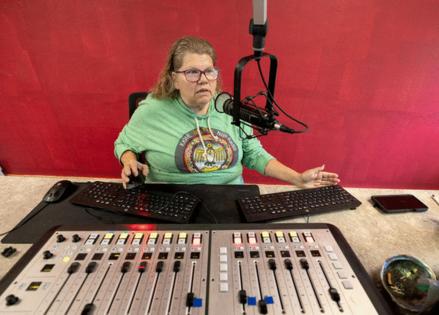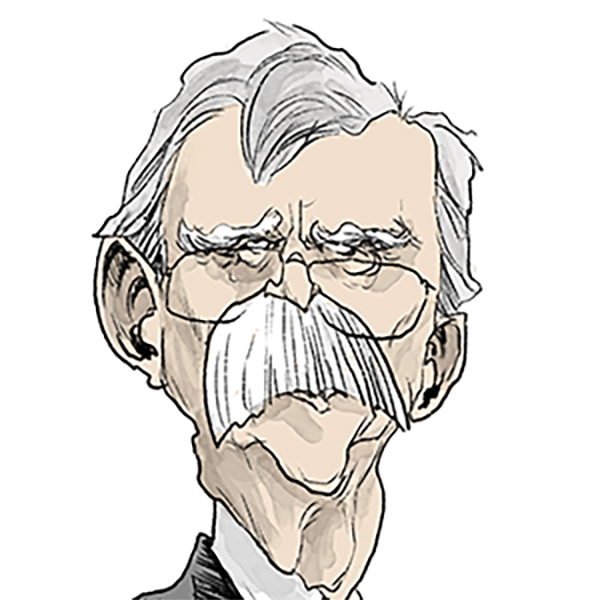Congress slashes public media funding in 'worst-case scenario' for some Minnesota stations
Published in Political News
Sarah Bignall didn’t get much sleep overnight Wednesday.
The general manager of KAXE radio in northern Minnesota was still awake at 2:45 a.m. watching C-SPAN’s livestream of the U.S. Senate vote on the rescissions package.
Shortly after senators approved the cancellation of some $9 billion in already-appropriated federal funds from the national budget, she typed a message to her staff and board.
“The worst-case scenario has happened,” she told them.
The bill, expected to be approved by the House, includes more than $1 billion in cuts targeting the Corporation for Public Broadcasting (CPB), which funds NPR and PBS. But more than 70% of that funding goes directly to outlets like KAXE, the oldest rural community radio station in the country.
After an hour of doomscrolling through Apple News and X, Bignall caught two hours of sleep, swiped on red lipstick, grabbed an iced coffee and headed to the station to face an uncertain future.
Members of Minnesota’s Republican congressional delegation did not respond immediately on Thursday for comment on their support for the Rescissions Act.
But last month, House Majority Whip Tom Emmer, a Republican from Delano, said the bill had supporters from groups such as the National Taxpayers Union and Heritage Action of America.
Upon the bill’s initial passage in the House on June 3, Emmer issued a statement saying the bill canceled “wasteful” spending on entities, including NPR and PBS.
“This is exactly what the American people deserve,” Emmer said.
Bill Walsh, director of communications and marketing at the conservative-leaning think tank Center of the American Experiment, applauded the vote.
“We’re trillions of dollars in debt. We’ve got to cut something,” said Walsh, whose office is in Minnetonka.
“This is an easy one. What’s the purpose of public funding when anyone with an internet account can create a YouTube channel or do a podcast? There are tons of ways to give information now. We don’t need one sponsored by government like we did in 1960.”
The cuts might force many local stations across the country, including in Minnesota, to decrease their operations — or even shutter — as soon as the fall. Many public broadcasters, including stations like Niijii Radio on the White Earth Reservation, receive more than 50% of their budgets from the Corporation for Public Broadcasting.
“If we lose the ability to broadcast this,” Niijii’s general manager Margaret Rousu told the Minnesota Star Tribune in late June, “many people are going to lose the ability to follow along with the tribal government and stuff that’s going on there.”
The late-night passage was possible after Sen. Mike Rounds, R-S.D., secured assurances from the Trump administration to fund tribal radio stations by redirecting money previously earmarked for an environmental fund within the Department of Interior.
For large swaths of Rounds’ mostly rural state, tribal radio stations are the only source of dependable dispatches for the emergency alert system.
Weather was also on Minnesota’s Sen. Amy Klobuchar’s mind Wednesday when she mentioned WTIP radio in Grand Marais during a speech on the floor.
“Do you think all these other stations are covering the Canadian wildfires?” Klobuchar asked. “They do. They hear it on WTIP.”
Klobuchar called into the station later on Wednesday to remind listeners of the importance of WTIP’s work.
Matthew Brown, WTIP’s executive director, said Klobuchar told the station that if not for them, “We would become a news desert because there’s just no other way to get the news in this area.”
The station receives $238,000 from the CPB, which Brown said makes up 25% of the radio station’s budget. He said the station might have to change programming, especially national programming that it buys with funds from CPB.
Klobuchar also spoke on KAXE’s airwaves last week. That station, which has 17 employees, relies on the CPB for about 13% of its budget. The PBS station in Bemidji has depended on federal funding for 37%.
KSMQ-TV in Austin received more than $870,000 in CPB funds for television community services last year, plus nearly $13,000 for system support.
That totaled nearly 40% of the station’s budget, said Kathleen Harrington, a member of KSMQ’s board of directors’ executive committee.
Harrington, who spent three decades working in Washington, D.C., said bundling so many provisions into large spending packages leaves little room to discuss the merits of individual programs.
“Public broadcasting gets caught up in the larger debate,” she said.
Norma Quam, 75, of Fosston, Minn., has listened to Cathy Erickson’s PolkaCast on Pioneer 90.1 for 25 years. A devoted polka fan, she regularly attends polka fests to catch Erickson’s live shows. Now, she’s worried.
The federal cuts to public media threaten the future of the Thief River Falls station, where CPB funds make up 40% of the budget. Quam said the community would be upset if the station went off the air, especially the older people in more rural areas.
“It’s important up here because a lot of them can’t get to all the activities in the big towns,” she said.
David Lipschitz, 68, lives in Isanti, Minn., a town of a little more than 7,000 people that’s an hour drive north of Minneapolis. But he rolls his eyes when he hears snippets on public radio, and he only watches PBS for the occasional music documentary.
“Using my tax dollars on something I can take or leave doesn’t make much sense to me,” said Lipschitz, a retired law enforcement officer.
“It’s so subjective. You might breathe and eat country-western music, and I might hate it. So why would we spend money on it? Because you like it?”
Stations lean less on government funds in metro areas, where membership drives help play a much bigger role in keeping the lights on. About 6% of last year’s budget at Minnesota Public Radio and American Public Media was from federal funding.
News of possible cuts helped the station reap nearly $2 million from 14,000 listeners during its most recent spring pledge drive, three times more than it did the previous year.
But the organization will still be affected. MPR/APM is second only to NPR in the distribution of syndicated programs. APM distributes programming to a nationwide network of more than 850 stations.
This includes programs like “Marketplace,” The “Splendid Table,” “This Old House Radio Hour,” “BBC World Service,” “The Daily” and “C24,” which provides nonstop classical music. Smaller stations with smaller budgets might not be able to afford those shows.
“Individual stations that get more than 30% from the government are going to have to make really hard choices about what they need to do,” said APM president Chandra Kavati. “They’ll need to see if they can afford to continue what they’re doing and pay what they have been.”
Kavati said her company will consider options, including lowering costs. Right now, she said, everything is on the table, including layoffs.
“This is uncharted territory for us right now,” said Anissa Rogness, MPR’s director of public affairs and government relations. “We’ll see how things fall out in the course of the next few months. We’re doing our best to meet the moment.”
_____
©2025 The Minnesota Star Tribune. Visit startribune.com. Distributed by Tribune Content Agency, LLC

























































Comments